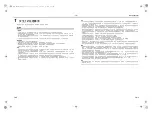
– 9 –
Owner’s Manual
EN-17
EN-18
6
Installation
Location
• Avoid installing near machines emitting high frequency waves.
• Not suitable for chemical plants such as liquefied carbon dioxide refrigerant plants.
• Do not install the air conditioner in locations where iron or other metal dust is present. If iron or other metal dust
adheres to or collects on the interior of the air conditioner, it may spontaneously combust and start a fire.
• A failure may occur in certain locations such as the following:
• Areas with large amount of oil droplets (including machine oil) or vapors
• Salty areas near oceans, etc.
• Hot springs emitting sulfidizing gas, etc.
• Heavily acidic or alkaline places.
Special maintenance or parts are required for use in the above places. For details, contact the dealer where you
purchased the product.
• Leave an enough space around the air intake and discharge of the outdoor unit so that the ventilation is not
restricted.
• Avoid places where strong wind may blow against the air intake and discharge of the outdoor unit.
• Attach a snow stand, snow hood, etc. to the outdoor unit for use in snowfall areas. For details, contact the dealer
where you purchased the product.
• Make sure drain water from the outdoor unit is emitted into places with good drainage.
• Make sure the air filter is attached to the indoor unit. If not, dust may accumulate on the heat exchanger or other
parts in the air conditioner and cause a water leak.
• Keep a distance of at least 1 m between the air conditioner / remote controller and a TV or radio. Failure to observe
this precaution may cause visual disturbance or noise.
• Leave a distance of at least 1.5 m between the air discharge and a fire alarm. If this precaution is not observed, the
alarm may not work properly or detect fire in case of fire.
Be careful of operation sounds
• Locate the unit in a place secure enough so that the sounds and vibrations do not increase.
• If something is placed near the air discharge of the outdoor unit, noise may increase.
• Be careful not to disturb your neighbors with cool / warm air or noise coming from the air discharge of the outdoor
unit.
7
Notes on Operations and Performance
Check before operation
• Turn on the power switch at least 12 hours before
starting operation.
• Make sure the earth wire is securely connected.
• Make sure the air filter is attached to the indoor unit.
Heating performance
• A heat pump system, which gathers outside heat and
emits it into a room, is used for heating. When the
outside air temperature falls, the heating capacity of
the unit is reduced.
• When the outside temperature is low, it is
recommended that you also use other heating
equipment.
Defrosting during heating
• If frost falls on the outdoor unit during heating,
defrosting is automatically performed (for
approximately 2 - 10 minutes) to increase the heating
effect.
• The fan of the indoor unit is stopped during defrosting.
3-minute protection
The outdoor unit will not operate for approximately 3
minutes after the air conditioner has been immediately
restarted after stopping, or the power switch has been
turned on. This is to protect the system.
Power failure
• In the case of a power failure, all operations stop.
• To resume operations, push the ON/OFF button.
Fan rotation of a stopped indoor
unit
While other indoor units operate, the fans on indoor units
in stand-by mode rotate for several minutes
approximately once per one hour to protect the
machines.
Cooling / heating operations
Each unit can be controlled individually. However, indoor
units connected to the same outdoor unit cannot perform
cooling and heating simultaneously.
When you attempt simultaneous operation, indoor units
performing cooling are stopped, and the running
preparation indicator
is displayed on the remote
controller.
An indoor unit performing heating continues running.
When you attempt an operation without the configured
settings, the running preparation indicator
is
displayed on the remote controller and operation stops.
If operation is fixed to cooling or heating by the air
conditioner administrator, only the configured settings
apply to the operation.
Characteristics of heating
• Air does not come out immediately after heating starts.
Heated air comes out after 3 to 5 minutes (depending
on the room / outside temperatures), after the indoor
heat exchanger warms up.
• When the outside temperature increases, the outdoor
unit may stop.
• While an indoor unit is running in the heating mode,
the outdoor unit supplies refrigerant to the other indoor
units which are not running.
Therefore, noise may come from the other indoor units
or the exterior of them may become warm.
• If the FAN operation is performed while the HEAT
operation is performed in another room, the fan does
not run.
1FAN_OM_EHV0000101-01.book Page 9 Thursday, September 13, 2018 5:10 PM











































